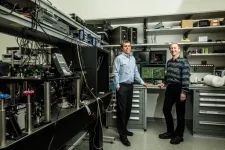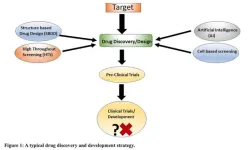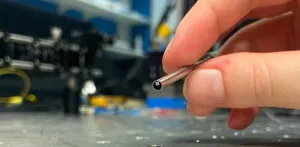Lighting up Alzheimer’s-related proteins to allow for earlier disease detection
2024-02-05
(Press-News.org) Many neurodegenerative diseases, including Alzheimer’s and Parkinson’s, are difficult to diagnose before symptoms begin to appear. However, disease-related biomarkers such as aggregated proteins called amyloids could provide important insight much earlier, if they can be readily detected. Researchers publishing in ACS Sensors have developed one such method using an array of sensor molecules that can light up amyloids. The tool could help monitor disease progression or distinguish between different amyloid-related conditions.
Neurodegenerative diseases typically involve a breakdown of communication within the brain that is often caused by “sticky” clumps of misfolded proteins called amyloids that interrupt signal transfer. These amyloids are thought to be closely related to the progression of Alzheimer’s disease, so they could be used as a means of early diagnosis to expand treatment options. Currently, radioimaging techniques including positron emission tomography (PET) scans can detect amyloids, but these methods rely on sophisticated equipment and typically focus on one of several amyloids involved in the disease. Instead, fluorescence imaging techniques have been explored as a simpler, yet still sensitive, means of detecting multiple specific amyloids. So, Margaret Sunde, Elizabeth New, Amandeep Kaur and colleagues wanted to develop a fluorescent sensor array for amyloids to monitor Alzheimer’s and other disease progression and to distinguish these atypical amyloids from similar, naturally occurring amyloid-forming proteins.
The team combined five coumarin-based molecular probes, each of which fluoresced to a different degree when it encountered the amyloids, into a sensor array. However, the team found that using just two of the probes with the strongest fluorescence responses still offered a high level of sensitivity and an identifiable fluorescent “fingerprint” for the individual amyloids.
The two-probe array was added to a sample mixture mimicking biological fluids containing molecules that could potentially interfere with sensing. Regardless, the array maintained a high sensitivity and selectivity. Its performance was also tested on samples taken from the brains of mouse models of Alzheimer’s. The team observed that the fluorescence patterns differed between early (at age 6 months) and later (at age 12 months) stages of the disease. Additionally, a unique fluorescence fingerprint was generated for three amyloids typically involved in Alzheimer’s, another disease-associated amyloid and five naturally occurring “functional amyloids” not involved in the disease. The researchers say that this tool could be used to distinguish between closely related amyloids and could inform new approaches for earlier and more confident diagnosis of amyloid-related diseases.
The authors acknowledge funding from the Australian Research Council and the National Health and Medical Research Council.
###
The American Chemical Society (ACS) is a nonprofit organization chartered by the U.S. Congress. ACS’ mission is to advance the broader chemistry enterprise and its practitioners for the benefit of Earth and all its people. The Society is a global leader in promoting excellence in science education and providing access to chemistry-related information and research through its multiple research solutions, peer-reviewed journals, scientific conferences, eBooks and weekly news periodical Chemical & Engineering News. ACS journals are among the most cited, most trusted and most read within the scientific literature; however, ACS itself does not conduct chemical research. As a leader in scientific information solutions, its CAS division partners with global innovators to accelerate breakthroughs by curating, connecting and analyzing the world’s scientific knowledge. ACS’ main offices are in Washington, D.C., and Columbus, Ohio.
To automatically receive news releases from the American Chemical Society, contact newsroom@acs.org.
Note: ACS does not conduct research, but publishes and publicizes peer-reviewed scientific studies.
Follow us: Twitter | Facebook | LinkedIn | Instagram
END
ELSE PRESS RELEASES FROM THIS DATE:
2024-02-05
Janelia scientists and longtime collaborators Eric Betzig and Harald Hess will be inducted into the 2024 class of the National Inventors Hall of Fame for their invention of photoactivated localization microscopy (PALM), a pioneering imaging technology that enables scientists to image live cells in super-resolution to study biological structures and processes in unprecedented detail.
Betzig, a senior fellow at Janelia and an HHMI Investigator at the University of California, Berkeley, and Hess, a senior ...
2024-02-05
Violence spreads in a contagious way like a disease among members of the Italian mafia, a new study shows.
Researchers have found committing violent acts with others increases the likelihood people in these groups will go on to carry out more violent offences in the future.
The analysis of the criminal careers of organised crime offenders shows previous violence has a “persistent and long-lasting” impact on their behaviour.
Prior violent co-offending has a greater impact than prior violent solo offending on the probability of future violence. Prior violent co-offending increases the probability ...
2024-02-05
Petrina Kamya, PhD, Head of AI Platforms and President of Insilico Medicine Canada, will present at the BIO CEO & Investor Conference happening Feb. 26-27 at the New York Marriott Marquis in New York City. Dr. Kamya will speak as part of the panel “AI within Biopharma: Separating Value from Hype,” on Feb. 27, 1pm ET along with Michael Nally, CEO of Generate: Biomedicines and Liz Schwarzbach, PhD, CBO of BigHat Biosciences.
The session will look at how the latest artificial intelligence (AI) tools – including generative AI and large language models – ...
2024-02-05
“[...] fruitful efforts to bring more drugs from bench to bedside could only be possible if we do not leave them ‘midway’!”
BUFFALO, NY- February 5, 2024 – A new editorial paper was published in Oncotarget's Volume 15 on January 24, 2024, entitled, “The fate of drug discovery in academia; dumping in the publication landfill?”
In this new editorial, researchers Uzma Saqib, Isaac S. Demaree, Alexander G. Obukhov, Mirza S. Baig, Amiram Ariel, and Krishnan Hajela, from Devi Ahilya Vishwavidyalaya, Indore, discuss drug discovery—a tedious process that is time consuming in both divulging whether a molecule is efficacious and specific in hitting ...
2024-02-05
In a warming climate, meltwater from Antarctica is expected to contribute significantly to rising seas. For the most part, though, research has been focused on West Antarctica, in places like the Thwaites Glacier, which has seen significant melt in recent decades.
In a paper published Jan. 19 in Geophysical Research Letters, researchers at Stanford have shown that the Wilkes Subglacial Basin in East Antarctica, which holds enough ice to raise global sea levels by more than 10 feet, could be closer to runaway melting than anyone realized.
“There hasn’t been much analysis in this region – there’s huge ...
2024-02-05
Gastrointestinal cancers (GCs) are among the most common forms of cancer and account for as much as one-third of all cancer deaths worldwide. Early diagnosis is an effective way of reducing the mortality associated with GCs, and endoscopic screening has proved to be an excellent approach for detecting potentially malignant tumors.
To extend the benefits of screening programs to as many people as possible, the imaging systems used should be inexpensive to manufacture and operate, yet accurate enough ...
2024-02-05
Bariatric surgery is more effective in controlling hypertension rates, or high blood pressure, in people with obesity and uncontrolled high blood pressure compared to blood pressure medication alone, according to a study published today in the Journal of the American College of Cardiology. People who underwent bariatric surgery had lower BMI and were on fewer medications after five years while maintaining normal blood pressure levels than those who only used antihypertensive medications.
According to the CDC, the U.S. obesity and hypertension rates in adults are 41.9% and 45.4%, respectively. Obesity is a known ...
2024-02-05
Numerous studies have raised alarms about how the COVID-19 pandemic disrupted learning, development and mental health among school-aged children. But few have focused on the effects felt by the 22 million children under age 6 who were not yet in school.
Now a study published Feb. 5, 2024, in JAMA Pediatrics, led by researchers at Cincinnati Children’s in collaboration with the Cincinnati Public Schools, documents the pandemic’s harmful effects on kindergarten readiness. The findings are based on data from about 8,000 kindergartners who took ...
2024-02-05
MSU has a satellite uplink/LTN TV studio and Comrex line for radio interviews upon request.
EAST LANSING, Mich. – As artificial intelligence technology advances, one area lags behind: voice-activated AI. For the more than 80 million people who stutter, voice AI technologies, which are increasingly being used in job hiring practices, can still be impossible to navigate.
HeardAI, a multidisciplinary project from Michigan State University, Western Michigan University, and the nonprofit Friends: The National Association of Young People Who Stutter, has advanced to Phase 2 of the National Science Foundation’s Convergence Accelerator program to ...
2024-02-05
Lowder & Foudray Receive Funding For Fairfax County Peer Recovery Services Evaluability Assessment
Evan Marie Lowder, Assistant Professor, Criminology, Law and Society, and Chelsea Foudray, Postdoctoral Research Fellow, Criminology, Law and Society, received funding from County of Fairfax for: "Fairfax County Peer Recovery Services Evaluability Assessment."
Lowder and Foudray are laying the groundwork for a formal evaluation of Fairfax County Peer Recovery Services (PRS) programming.
For ...
LAST 30 PRESS RELEASES:
[Press-News.org] Lighting up Alzheimer’s-related proteins to allow for earlier disease detection



